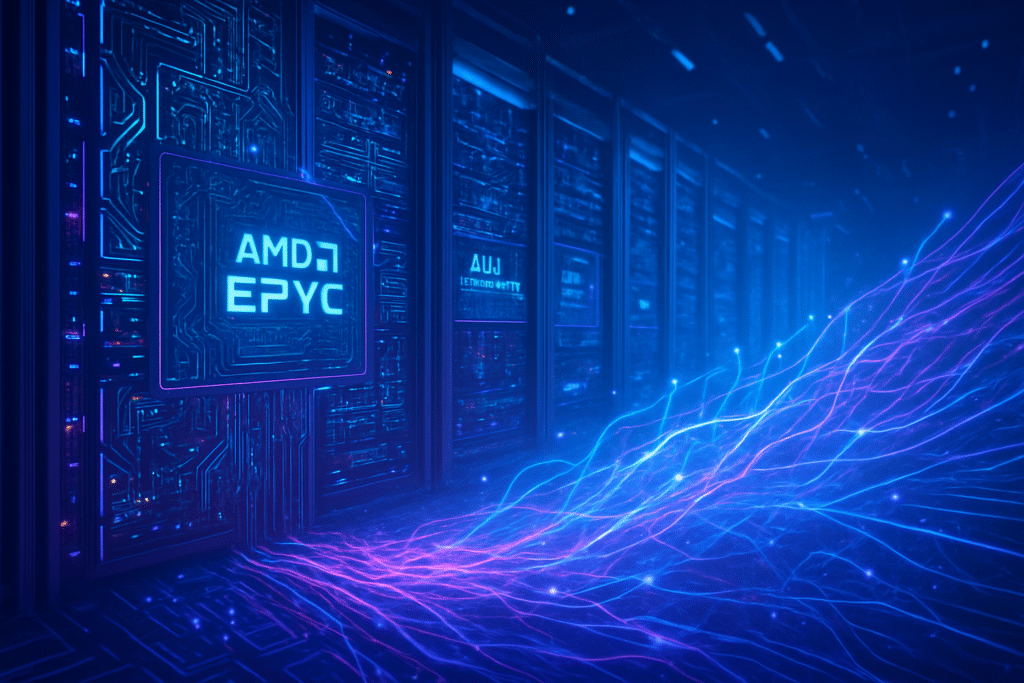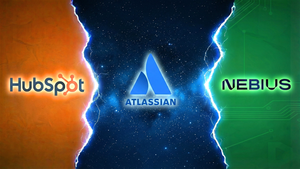Financial News
AMD Ignites Semiconductor Industry with AI Surge, Reshaping the Tech Landscape

San Francisco, CA – November 5, 2025 – Advanced Micro Devices (NASDAQ: AMD) is not merely participating in the current tech stock rebound; it's spearheading a significant shift in the semiconductor industry, driven by its aggressive foray into artificial intelligence (AI) and high-performance computing (HPC). With record-breaking financial results and an ambitious product roadmap, AMD is rapidly solidifying its position as a critical player, challenging established giants and fostering a new era of competition and innovation in the silicon supercycle. This resurgence holds profound implications for AI development, cloud infrastructure, and the broader technological ecosystem.
AMD's robust performance, marked by a stock appreciation exceeding 100% year-to-date, underscores its expanding dominance in high-value markets. The company reported a record $9.2 billion in revenue for Q3 2025, a substantial 36% year-over-year increase, fueled primarily by stellar growth in its data center and client segments. This financial strength, coupled with strategic partnerships and a maturing AI hardware and software stack, signals a pivotal moment for the industry, promising a more diversified and competitive landscape for powering the future of AI.
Technical Prowess: AMD's AI Accelerators and Processors Drive Innovation
AMD's strategic thrust into AI is spearheaded by its formidable Instinct MI series accelerators and the latest generations of its EPYC processors, all built on cutting-edge architectures. The Instinct MI300 series, leveraging the CDNA 3 architecture and advanced 3.5D packaging, has already established itself as a powerful solution for generative AI and large language models (LLMs). The MI300X, a GPU-centric powerhouse, boasts an impressive 192 GB of HBM3 memory with 5.3 TB/s bandwidth, allowing it to natively run massive AI models like Falcon-40 and LLaMA2-70B on a single chip, a crucial advantage for inference workloads. Its peak theoretical performance reaches 5229.8 TFLOPs (FP8 with sparsity). The MI300A, the world's first data center APU, integrates 24 Zen 4 x86 CPU cores with 228 CDNA 3 GPU Compute Units and 128 GB of unified HBM3 memory, offering versatility for diverse HPC and AI tasks by eliminating bottlenecks between discrete components.
Building on this foundation, AMD has rapidly advanced its product line. The Instinct MI325X, launched in October 2024, features 256GB HBM3E memory and 6 TB/s bandwidth, showing strong MLPerf results. Even more significant is the Instinct MI350 series, based on the advanced CDNA 4 architecture and TSMC's 3nm process, which entered volume production ahead of schedule in mid-2025. This series, including the MI350X and MI355X, promises up to 4x generation-on-generation AI compute improvement and an astounding 35x leap in inferencing performance over the MI300 series, with claims of matching or exceeding Nvidia's (NASDAQ: NVDA) B200 in critical training and inference workloads. Looking further ahead, the MI400 series (CDNA 5 architecture) is slated for 2026, targeting 40 PFLOPs of compute and 432GB of HBM4 memory with 19.6 TB/s bandwidth as part of the "Helios" rack-scale solution.
AMD's EPYC server processors are equally vital, providing the foundational compute for data centers and supporting Instinct accelerators. The 5th Gen EPYC "Turin" processors (Zen 5 architecture) are significantly contributing to data center revenue, reportedly offering up to 40% better performance than equivalent Intel (NASDAQ: INTC) Xeon systems. The upcoming 6th Gen EPYC "Venice" processors (Zen 6 architecture on TSMC's 2nm process) for 2026 are already showing significant improvements in early lab tests. These CPUs not only handle general-purpose computing but also form the host infrastructure for Instinct GPUs, providing a comprehensive, integrated approach for AI orchestration.
Compared to competitors, AMD's MI300 series holds a substantial lead in HBM memory capacity and bandwidth over Nvidia's H100 and H200, which is crucial for fitting larger AI models entirely on-chip. While Nvidia's CUDA has long dominated the AI software ecosystem, AMD's open-source ROCm platform (now in version 7.0) has made significant strides, with the performance gap against CUDA narrowing dramatically. PyTorch officially supports ROCm, and AMD is aggressively expanding its support for leading open-source models, demonstrating a commitment to an open ecosystem that addresses concerns about vendor lock-in. This aggressive product roadmap and software maturation have drawn overwhelmingly optimistic reactions from the AI research community and industry experts, who see AMD as a formidable and credible challenger in the AI hardware race.
Reshaping the AI Landscape: Impact on Industry Players
AMD's ascendancy in AI is profoundly affecting the competitive dynamics for AI companies, tech giants, and startups alike. Major cloud infrastructure providers are rapidly diversifying their hardware portfolios, with Microsoft (NASDAQ: MSFT) Azure deploying MI300X accelerators for OpenAI services, and Meta Platforms (NASDAQ: META) utilizing EPYC CPUs and Instinct accelerators for Llama 405B traffic. Alphabet (NASDAQ: GOOGL) is offering EPYC 9005 Series-based VMs, and Oracle (NYSE: ORCL) Cloud Infrastructure is a lead launch partner for the MI350 series. These tech giants benefit from reduced reliance on a single vendor and potentially more cost-effective, high-performance solutions.
AI labs and startups are also embracing AMD's offerings. OpenAI has forged a "game-changing" multi-year, multi-generation agreement with AMD, planning to deploy up to 6 gigawatts of AMD GPUs, starting with the MI450 series in H2 2026. This partnership, projected to generate over $100 billion in revenue for AMD, signifies a major endorsement of AMD's capabilities, particularly for AI inference workloads. Companies like Cohere, Character AI, Luma AI, IBM (NYSE: IBM), and Zyphra are also utilizing MI300 series GPUs for training and inference, attracted by AMD's open AI ecosystem and its promise of lower total cost of ownership (TCO). Server and OEM partners such as Dell Technologies (NYSE: DELL), Hewlett Packard Enterprise (NYSE: HPE), Lenovo, and Supermicro (NASDAQ: SMCI) are integrating AMD's AI hardware into their solutions, meeting the escalating demand for AI-ready infrastructure.
The competitive implications for market leaders are significant. While Nvidia (NASDAQ: NVDA) still commands over 80-90% market share in AI processors, AMD's MI350 series directly challenges this stronghold, with claims of matching or exceeding Nvidia's B200 in critical workloads. The intensified competition, driven by AMD's accelerated product releases and aggressive roadmap, is forcing Nvidia to innovate even faster. For Intel (NASDAQ: INTC), AMD's 5th Gen EPYC "Turin" processors have solidified AMD's position in the server CPU market, outperforming Xeon systems in many benchmarks. In the client PC market, both Intel (Core Ultra) and AMD (Ryzen AI processors) are integrating Neural Processing Units (NPUs) for on-device AI, disrupting traditional PC architectures. AMD's strategic advantages lie in its open ecosystem, aggressive product roadmap, key partnerships, and a compelling cost-effectiveness proposition, all positioning it as a credible, long-term alternative for powering the future of AI.
Wider Significance: A New Era of AI Competition and Capability
AMD's strong performance and AI advancements are not merely corporate successes; they represent a significant inflection point in the broader AI landscape as of November 2025. These developments align perfectly with and further accelerate several critical AI trends. The industry is witnessing a fundamental shift towards inference-dominated workloads, where AI models move from development to widespread production. AMD's memory-centric architecture, particularly the MI300X's ability to natively run large models on single chips, offers scalable and cost-effective solutions for deploying AI at scale, directly addressing this trend. The relentless growth of generative AI across various content forms demands immense computational power and efficient memory, requirements that AMD's Instinct series is uniquely positioned to fulfill.
Furthermore, the trend towards Edge AI and Small Language Models (SLMs) is gaining momentum, with AMD's Ryzen AI processors bringing advanced AI capabilities to personal computing devices and enabling local processing. AMD's commitment to an open AI ecosystem through ROCm 7.0 and support for industry standards like UALink (a competitor to Nvidia's NVLink) is a crucial differentiator, offering flexibility and reducing vendor lock-in, which is highly attractive to hyperscalers and developers. The rise of agentic AI and reasoning models also benefits from AMD's memory-centric architectures that efficiently manage large model states and intermediate results, facilitating hyper-personalized experiences and advanced strategic decision-making.
The broader impacts on the tech industry include increased competition and diversification in the semiconductor market, breaking Nvidia's near-monopoly and driving further innovation. This is accelerating data center modernization as major cloud providers heavily invest in AMD's EPYC CPUs and Instinct GPUs. The democratization of AI is also a significant outcome, as AMD's high-performance, open-source alternatives make AI development and deployment more accessible, pushing AI beyond specialized data centers into personal computing. Societally, AI, powered by increasingly capable hardware, is transforming healthcare, finance, and software development, enabling personalized medicine, enhanced risk management, and more efficient coding tools.
However, this rapid advancement also brings potential concerns. Supply chain vulnerabilities persist due to reliance on a limited number of advanced manufacturing partners like TSMC, creating potential bottlenecks. Geopolitical risks and export controls, such as U.S. restrictions on advanced AI chips to China, continue to impact revenue and complicate long-term growth. The escalating computational demands of AI contribute to substantial energy consumption and environmental impact, requiring significant investments in sustainable energy and cooling. Ethical implications, including potential job displacement, algorithmic bias, privacy degradation, and the challenge of distinguishing real from AI-generated content, remain critical considerations. Compared to previous AI milestones, AMD's current advancements represent a continuation of the shift from CPU-centric to GPU-accelerated computing, pushing the boundaries of specialized AI accelerators and moving towards heterogeneous, rack-scale computing systems that enable increasingly complex AI models and paradigms.
The Road Ahead: Future Developments and Expert Predictions
AMD's future in AI is characterized by an ambitious and well-defined roadmap, promising continuous innovation in the near and long term. The Instinct MI350 series will be a key driver through the first half of 2026, followed by the MI400 series in 2026, which will form the core of the "Helios" rack-scale platform. Looking beyond, the MI500 series and subsequent rack-scale architectures are planned for 2027 and beyond, integrating next-generation EPYC CPUs like "Verano" and advanced Pensando networking technology. On the CPU front, the 6th Gen EPYC "Venice" processors (Zen 6 on TSMC's 2nm) are slated for 2026, promising significant performance and power efficiency gains.
The ROCm software ecosystem is also undergoing continuous maturation, with ROCm 7.0 (generally available in Q3 2025) delivering substantial performance boosts, including over 3.5x inference capability and 3x training power compared to ROCm 6. These advancements, coupled with robust distributed inference capabilities and support for lower-precision data types, are crucial for closing the gap with Nvidia's CUDA. AMD is also launching ROCm Enterprise AI as an MLOps platform for enterprise operations. In the client market, the Ryzen AI Max PRO Series processors, available in 2025, with NPUs capable of up to 50 TOPS, are set to enhance AI functionalities in laptops and workstations, driving the proliferation of "AI PCs."
These developments open up a vast array of potential applications and use cases. Data centers will continue to be a core focus for large-scale AI training and inference, supporting LLMs and generative AI applications for hyperscalers and enterprises. Edge AI solutions will expand into medical diagnostics, industrial automation, and self-driving vehicles, leveraging NPUs across AMD's product range. AMD is also powering Sovereign AI factory supercomputers, such as the Lux AI supercomputer (early 2026) and the future Discovery supercomputer (2028-2029) at Oak Ridge National Laboratory, advancing scientific research and national security. Beyond standard products, AMD is selectively pursuing custom silicon solutions in defense, automotive, and hyperscale computing.
However, significant challenges remain. Intense competition from Nvidia and Intel necessitates flawless execution of AMD's ambitious product roadmap. The software ecosystem maturity of ROCm, while rapidly improving, still needs to match CUDA's developer adoption and optimization. Geopolitical factors like export controls and potential supply chain disruptions could impact production and delivery. Experts maintain a generally positive outlook, anticipating substantial revenue growth from AMD's AI GPUs, with some projecting data center GPU revenue to reach $9.7 billion in 2026 and $13.1 billion in 2027. The OpenAI partnership is considered a significant long-term driver, potentially generating $100 billion by 2027. While Nvidia is expected to remain dominant, AMD is well-positioned to capture significant market share, especially in edge AI applications.
A New Chapter in AI History: The Long-Term Impact
AMD's current strong performance and aggressive AI strategy mark a new, highly competitive chapter in the history of artificial intelligence. The company's relentless focus on high-performance, memory-centric architectures, combined with a commitment to an open software ecosystem, is fundamentally reshaping the semiconductor landscape. The key takeaways are clear: AMD is no longer just an alternative; it is a formidable force driving innovation, diversifying the AI supply chain, and providing critical hardware for the next wave of AI advancements.
This development's significance in AI history lies in its potential to democratize access to cutting-edge AI compute, fostering broader innovation and reducing reliance on proprietary solutions. The increased competition will inevitably accelerate the pace of technological breakthroughs, pushing both hardware and software boundaries. The long-term impact will be felt across industries, from more efficient cloud services and faster scientific discovery to more intelligent edge devices and a new generation of AI-powered applications that were previously unimaginable.
In the coming weeks and months, the industry will be watching closely for several key indicators. The continued maturation and adoption of ROCm 7.0 will be crucial, as will the initial deployments and performance benchmarks of the MI350 series in real-world AI workloads. Further details on the "Helios" rack-scale platform and the MI400 series roadmap will provide insights into AMD's long-term competitive strategy against Nvidia's next-generation offerings. AMD's ability to consistently execute on its ambitious product schedule and translate its strategic partnerships into sustained market share gains will ultimately determine its enduring legacy in the AI era.
This content is intended for informational purposes only and represents analysis of current AI developments.
TokenRing AI delivers enterprise-grade solutions for multi-agent AI workflow orchestration, AI-powered development tools, and seamless remote collaboration platforms.
For more information, visit https://www.tokenring.ai/.
More News
View More




Recent Quotes
View More
Quotes delayed at least 20 minutes.
By accessing this page, you agree to the Privacy Policy and Terms Of Service.



